(or Torturing Children can be Ignored, but only sometimes)

This is a reply to some of Noah’s comments following his review of Lady Snowblood which can be found here. From the looks of things, this might be a manga themed week at The Hooded Utilitarian.
In his final comments, Noah writes:
“Well, there’s appalling morality and then there’s appalling morality. I don’t have any trouble with lots of things that are variously horrific, from Johnny Ryan to Female Prisoner Scorpion to slasher films.”
It’s difficult for me to mount an adequate defense of the manga of Kazuo Koike (and Lady Snowblood is somewhat typical of Koike) since I’m not really that much of a fan. In fact, I’m pretty much totally detached from his works in the same way I’m pretty detached from Alex Raymond’s Flash Gordon – interested enough to recognize him as an important voice in manga but not enough to recommend him to anyone with only a peripheral interest in comics.
But on to Noah’s comments.
I view Johnny Ryan in much the same way I view someone like Takashi Nemoto or Mike Diana. Ryan is obviously a far better artist than Diana but both depict scenes which are so over the top that none but the most deluded would suspect that the author is actually promoting the kind of behavior being depicted.
Lady Snowblood is drawn in a fashion that encourages a more realistic reading of the author’s intentions (as Noah indicates). But it also comes from a genre with certain conventions; conventions where the level of dignity accorded fellow humans is considerably diminished as befits a drama set in an earlier period of human history. Whether these levels of degradation are actively promoted and approved by Koike in Lady Snowblood is a matter of perception. I didn’t detect that level of approbation but this might be due to my over consumption of such pieces. The number of Chinese period dramas I’ve seen where children have been trained to exact vengeance for the honor of the clan or family is such that my eyes glaze over whenever the plotline comes up.
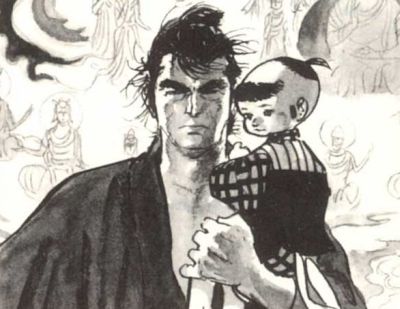
It’s interesting that Richard didn’t have any problems with Lone Wolf and Cub since (if you look at the series through the lens which Noah has cast on Lady Snowblood) it’s really far more reprehensible. A manga depicting a toddler being taught the arts of violence and engaging passively in murder at the behest of his father and this as one of the main themes of the book – Noah would have a field day with this one.
If there is an underlying philosophy in any of Koike’s samurai dramas, it is that “the ends justifies the means”. He and his most enthusiastic readers see his protagonist as the unassailable hand of justice in the absence of an all powerful God. Is it any wonder that a right winger like Frank Miller finds Lone Wolf and Cub so compelling? Though it would not surprise me to find out that Koike shares values in common with Miller, Lady Snowblood in itself is less problematic in this regard because it is distanced by the period it is set in.
Noah again, first towards the tail end of his piece and later in his final comments:
“Your honor is your psychology, your personal motivation, your soul — that’s all there is to you. As such, the individual is, in fact a means, and the end is the family or the collective or, ultimately, the nation. And, again, that seems a fair approximation of fascism. As a mealy-mouthed liberal relativist embarrassed about his own Judeo-Christian heritage it’s hard for me to come out and say this, but — I think that’s evil, damn it.”
“I mean, I guess you can say, “well nobody takes it seriously” and have that be that. But I don’t know; the film is carefully shot; and the moral/honor code discussed is insistently and enthusiastically sold. It’s not clear to me why the fact that it’s broadly accepted is supposed to make it better. Blackface representations are rife in old beloved comics, and more or less accepted as part and parcel of their greatness. As you discussed, this is not necessarily ideal.”
My indifference to these themes might be my way of giving fans of this genre of manga the benefit of the doubt. The values espoused here are so much a part of the ethos of Japanese period and samurai dramas in particular (and, who knows, modern Japanese life to a lesser extent), that to denigrate them would be in fact to denigrate a very important aspect of Japanese culture and the Japanese themselves. These themes are clearly to be seen even in “new age” samurai dramas like those directed by Yoji Yamada (Twilight Samurai, The Hidden Blade) where these questions are ever present and of utmost importance in dictating the actions of the players. These are the values which have sustained Japanese culture and civilization for centuries. I hesitate to cast aspersions on them for looking upon times past with a modicum of respect. I appreciate these differences both in their art and lives, and cannot see that they inevitably lead to the promotion of a fascist state.
I have no doubt that the honor code was enthusiastically sold by Koike but I cannot remember if the abuse of the young Snowblood was treated with the same glee. My feeling is that whenever such scenes are depicted, it is more often to apprise the reader of the protagonist’s level of determination and hatred; an attempt to shock the reader with the level of vindictiveness a human being is capable of achieving and bequeathing. It has less to do with the gleeful torture of children in print than the use of age old genre conventions found for decades in tales of revenge.
It is certainly all to easy for someone of Chinese origin like myself to take a number of anime and manga to task for their unapologetic militarism and lack of shame concerning the events of WW2, but I don’t know if to do so has any benefits beyond the intellectual at this point in time (at least for me). If unguarded, such perceptions might lead to an unhealthy level of mistrust and suspicion if not outright racism. And I have enough of that kind of thing from all the Chinese and Korean media I consume.
__________________________________
ADDENDUM (a response by Timothy Finney)
I asked a long time comics reader (who happens to lives in Japan with his Japanese wife and child) to comment on Noah’s piece. He replied with the following (lines placed between paragraphs because WordPress won’t allow me to create paragraph breaks later in the piece for some reason):
I’m not sure what to write exactly, but Suat asked me for my two cents worth, so here goes.
I can’t write too much about the actual series as I’ve only heard about it, not read it or seen the movie. (I saw a movie that bore some similarities, though.)
However, I have lived in Japan for about 20 years and I can say that trying to extrapolate too much about Japanese culture from its fiction, however tempting, will drive you mad due to all the contradictions. Compare this, which was made for a men’s magazine, with the usual Tezuka-style manga with its world peace, anti-war message. These things are never cut and dry. For every ying there is a yang. (So, the “Welcome to Japan” comment seems a bit off to me compared to the boring reality of the country. No, cold-blooded warrior drone army being bred in any of the public schools I’ve taught at, anyway.)
As for the manga itself, I checked the Japanese title, which is kind of funny in that it is a play on the Japanese title for Snow White. Shura yuki hime (or Blood-Splattered Snow Princess) vs Shiro Yuki Hime (or White Snow Princess). Heh. Also, I checked the plot, and except for the main character’s origin, it seems pretty typical, the twist, as noted by Suat, aside. (By the way, I have little tolerance for the I Spit on Your Graves of the world, just not my bag, and while I admit to seeing a splatter movie or two over the years, I can’t say I’ve ever found them all that interesting, now less than ever. So with regards to one’s personal enjoyment of a series, that seems to me valid, but something that does not always apply from person to person.)
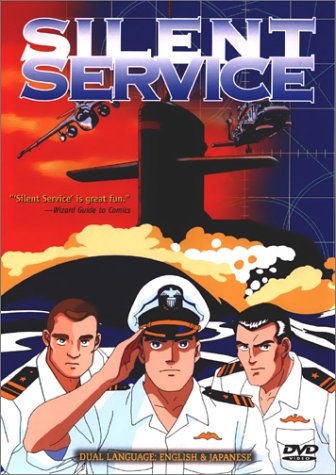
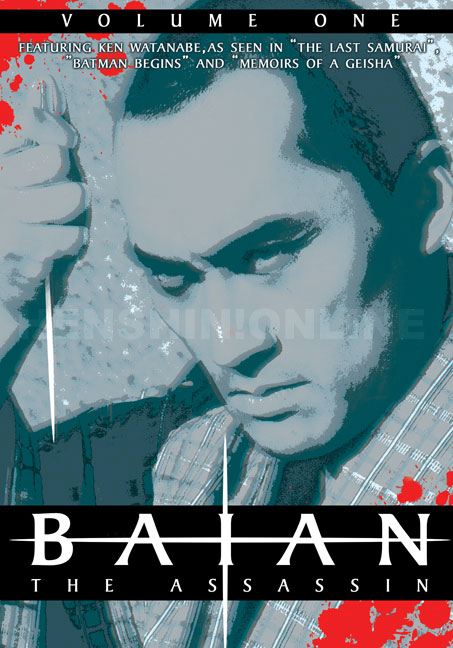
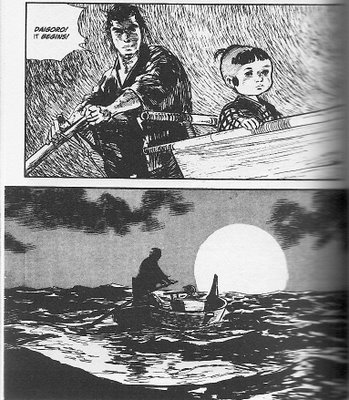
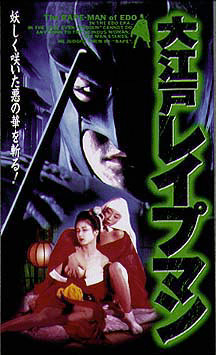

Suat says, “If unguarded, such perceptions might lead to an unhealthy level of mistrust and suspicion if not outright racism.”
I think that’s very fair. On the other hand, however, I think that it can be useful to examine the underlying cultural more at play.
I personally believe that torturing children is evil. I haven’t read Lady Snowblood, and I now have no interest in reading it.
I strongly disagree with Bill that this is a Japanese thing. I think considering children to be a tool to be used for societal or family good is a widely held concept (and a reprehensible one in some ways, easily abused, and too often used for petty adult exploitation of the child). In America, legal protection for abused children was based on animal abuse laws. The protection for animals came before those of children. There are certain advantages to considering people as a continuum–it’s easier to amass capital (a house, a business) that can be handed down to generations, for example.
I guess what I’m getting at is that this kind of tale of child-monsters is a common one across cultures. I’m surprised that Ender’s Game hasn’t been brought up before, but it is the one that springs to mind the most.
Hey Suat. This is a really interesting take — and much more thoughtful than my off the cuff nattering. But will that stop me from responding? Hell no.
I was trying to make it somewhat clear at least that my distaste for Lady Snowblood was specifically for Lady Snowblood, not for Japanese culture as a whole (as I said, Ooku deals with similar issues very differently — and even other Japanese female revenge films don’t hit me the same way.)
On the other hand, I don’t see the argument that “it’s part of Japanese culture, and therefore not evil” as especially compelling. Again, racism is part of American culture — indeed, an important, even integral part, without which we’d be very different. Nonetheless, racism is a really bad thing, and worth sneering at when it comes up. I think that the kind of honor-over-all sentiment that shows up in Lady Snowblood has pretty evil implications.
I think that’s worth pointing out — in part precisely because, as VM says, they’re implications that exist in our culture too. Ender’s Game is a pretty interesting example, as is Frank Miller. The honor in Japanese culture is one of the things we in the west often find attractive. It’s worth thinking about why, and about whether that’s really such a great idea.
VM: The torture of children is not only evil, it’s also one of the most heinous crimes in most socieities.
The depiction of such acts is a much more complex issue and may come down to a question of degrees and intentions. That would require a whole other essay. Anime is simply filled with stories depicting the mental or physical torture of minors: Mobile Suit Gundam, Neon Genesis, Serial Experiments Lain, Gunslinger Girl etc. It’s almost impossible to avoid if one is seeking to “complete” one’s knowledge of the form. I wonder what this says about Japanese culture and society.
I think Ender’s Game has escaped notice here because Orson Scott Card more or less shakes his head at the abuse depicted in the early pages of his novel (or at least that’s my impression from a single reading over 2 decades ago). There’s also his more pacifist Speaker for the Dead to soften the violence/genocide depicted in Ender’s Game.
“My indifference to these themes might be my way of giving fans of this genre of manga the benefit of the doubt. The values espoused here are so much a part of the ethos of Japanese period and samurai dramas in particular…”
That’s similar to where I’m coming from as a reader, even though I don’t have Suat’s familiarity with manga. The honor-over-all mentality in “Lady Snowblood” (or “Lone Wolf and Cub”) is part of the universe of the comic, and I don’t find it to be personally offensive, even though I would never want to live in a world where that way of thinking was dominant.
It’s strange, because I completely understand where Noah is coming from, and I can’t really dispute his main point, but I don’t share his outrage. Maybe it’s because I don’t have a child, so fucked up parenting is mostly an academic concern for me.
I often have a hard time with some of the more shonen anime and manga, like the Gundam series. I’ve found a manga called Claymore that is part of this meme, I think, which was highly recommended to me by several friends as an interesting story that turns this trope upside down. I’ve only just started it, but maybe I’ll try and read more and blog about it. Have you read it?
I wonder if the robot-turned-person is also part of this tradition. What do you think?
Ender’s Game drove me nuts when I read it, as did Speaker for the Dead, but I read them about ten years ago. Card’s politics are very, um, loud in certain ways (he is adamantly homophobic and also quite far to the right) but I haven’t read enough Frank Miller to know if they are similar or not. I just think of it as a similar use of the children. Many people I know felt that the abuse portrayed in Ender’s Game was a case of the end justifying the means.
Noah: “On the other hand, I don’t see the argument that “it’s part of Japanese culture, and therefore not evil” as especially compelling…I think that the kind of honor-over-all sentiment that shows up in Lady Snowblood has pretty evil implications.”
Well, it wasn’t meant to be an especially compelling argument and I’m sure that many mainland Chinese and Koreans would agree with you. There’s really quite a bit in Japanese art/popular culture to beat them about the head with but to what end? The Sinic races of Asia don’t really need to be taught to be any more suspicious of the Japanese. The privileging of honor (or nationalism) has its uses in society providing it’s kept in check. It’s not unreservedly bad like racism.
“but to what end?”
It’s really not about beating the Japanese about the head — I mean, really, what do they care what I have to say? I hardly have an audience in the U.S.; I doubt the two people in Japan who have ever read this blog really give a whoop.
As I said, for the audience I’ve got, and for me specifically and primarily, the end is that this stuff is popular here too — both directly taken from Japan and homegrown. I’ve been thinking about the desire for the real (reading Zizek) and that definitely plays in here. Ender’s Game does look different when you put it next to Lady Snowblood, too. I think the nostalgia for honor (Japanese and otherwise) still has a huge role in our culture. As you say, that’s not categorically bad in the way that racism is. But there are huge downsides which are often elided. To me, that’s worth talking and/or thinking about.
VM: It’s definitely interesting for me to get a “Western” view on such matters. I haven’t read Claymore since I’ve lost interest in most of those Shonen titles except for maybe Naruto and One Piece (now there’s a great title about friendship which treats childhood trauma with some sensitivity).
Isn’t it interesting that neither American children nor their parents seem to be bothered by what Naruto and especially Sasuke (both around 12 years of age I think) go through in Naruto? Lots of honor/vengeance-over-all to go round over there as well.
Which robot turned person story are you thinking about?
As for Orson Scott Card, I didn’t pick up on his homophobia or right wing credentials – far too young and innocent at the time I guess. He’s nowhere close to being a favorite writer but it’s interesting information to have.
Noah: I think I can agree with just about everything in your last comment.
To clarify my flip comment, “Welcome to Japan” referred to Noah’s distaste for suppressed individuality rather than anything to do with violence, as Timothy Finney reads it. I don’t care for samurai dramas generally, and I seem to have focused on one thing (mealy-mouthed liberal relativist embarrassed about his own Judeo-Christian heritage finding fascism in collectivism) while everyone else focuses on juicier questions, so that’s that.
Also, I wanted to give a belated “shout out” to Suat for his “fried manga testicles” comment in the other thread. Fine work, and perhaps one can find some in a hawker stall in Lau Pa Sat Food Center.
I’m about a week late to the party, but I felt the need to comment anyways because of the interesting relationship I see between this post and Berlatsky’s original post. The relationship being pretty much that of one to one’s father’s brother’s nephew’s cousin’s former roommate…that is absolutely nothing. Bad American pop culture references aside, the point that this post makes is so divergent from that of Berlatsky’s original that rather being a response or a refutation, comes off as an unrelated post altogether (and I am including the addendum in this). Both it and the addendum are strawmen, albeit among the most polite of strawmen arguments I’ve witnessed.
In order to illustrate my point, I will have to be horrifically reductive; I do apologize for the essentialization. To me, Berlatsky’s main point is “utilizing one’s children as the means to achieve an end is wrong because I believe each person to be an individual rather than merely a single part in a collective.” From there, he extrapolates several secondary points about how to him the “person as only one part of the whole” mentality might lend itself to militarism and facism, but those are secondary points built on the foundation of the main one. Ng’s refutation reads like this: “I cannot see your point because I consume a lot of media in which this is the case” and “using children as a means to an end/torturing children falls under cultural relativity and so I refuse to analyze it” and “torturing children is not problematic because it serves a story-driving purpose” and “critiquing the militarism present in Japanese comics will lead to racism.”
Not one point in Ng’s highly distinct arsenal of points addresses Berlatsky’s point. There are a number of ways in which Berlatsky’s point might be refuted such as biological or philosophical reasons why children are already a means to an end, anthropological reasons why a collective identity that supercedes an individual identity is actually beneficial, or textual evidence on pages x, y, and z as to how Lady Snowblood actually subverts the whole thing. Invoking cultural relativity as a strawman against analysis of anything potentially problematic is problematic in itself because any number of things can fall under that umbrella; for instance, female genital cutting, which is exactly the horror it sounds like. FGC is a very culturally specific practice done in very culturally distinct places of the world, does that make it immune to analysis and condemnation by human rights activists (or any human being for that matter)? Of course cultural sensitivity has to be employed in the treatment of this very delicate issue (which is why the analysis part is so important), but that doesn’t mean we stop condemning it. As for the “her torture serves to drive the plot” argument, three words: Women in Refrigerators. This argument, which I have borrowed from feminist comic/pop culture critique, makes the point that just because something serves a purpose does not mean that it is not problematic. Just because the death/injury of a female close to the male protagonist is often the plot device driving him towards heroism doesn’t mean it’s not a representation of sexist tendencies in Western comic book narratives.
Finally, the idea that critiquing something problematic will lead to racism is one that I run into everyday and one that I’m actually quite (unpleasantly) surprised to run into on this blog, which is ostensibly all about critiquing comics. First and foremost, this is completely to the left field as militarism in Lady Snowblood isn’t really Berlatsky’s original point, just how what is present in Lady Snowblood (torturing children/children as a means to an end) might lend itself to militarism. But even disregarding the need for an argument to be on point…what? More often than not, it’s the blind acceptance of the messages the media spoon-feeds us that is the problem, not the critique. I’m not saying that mistrust of the Japanese in Chinese/Korean media doesn’t exist or that it’s not a problem; I am saying that that doesn’t somehow give Japanese media a free pass against its own problems. One of these problems might be militarism, which Ng and Finney are quick to dismiss, another of which, the one Berlatsky actually questions, might be the representation of using children as the means to an end as acceptable.
The reason for this obscenely long and more than slightly annoyed comment is because I was intrigued by a number of questions Berlatsky’s original post posed, and the 2 responses frustrated me because they categorically dismissed some of the questions and then proceeded to argue a number of unrelated things. Of COURSE “trying to extrapolate too much about Japanese culture from its fiction…will drive you mad due to all the contradictions,” but that’s true of every culture, (American fiction gave us both Uncle Tom’s Cabin and The Turner Diaries!) it doesn’t mean we halt all literary analysis. These are things worth thinking about and deconstructing and talking about, and that is one conversation I would love to have.
I don’t think Suat set up a straw man exactly; he didn’t mischaracterize my position, just came at the questions from a different perspective.
My take on children and autonomy was probably most influenced by this essay which I happened to read earlier. It’s a Catholic perspective on sex-selection, but the arguments work even better for having a kid solely to use her to enact bloody revenge.
I like Rapeman. It’s written and illustrated by a woman. I get to look at the rape fantasies that a woman dreamed of.